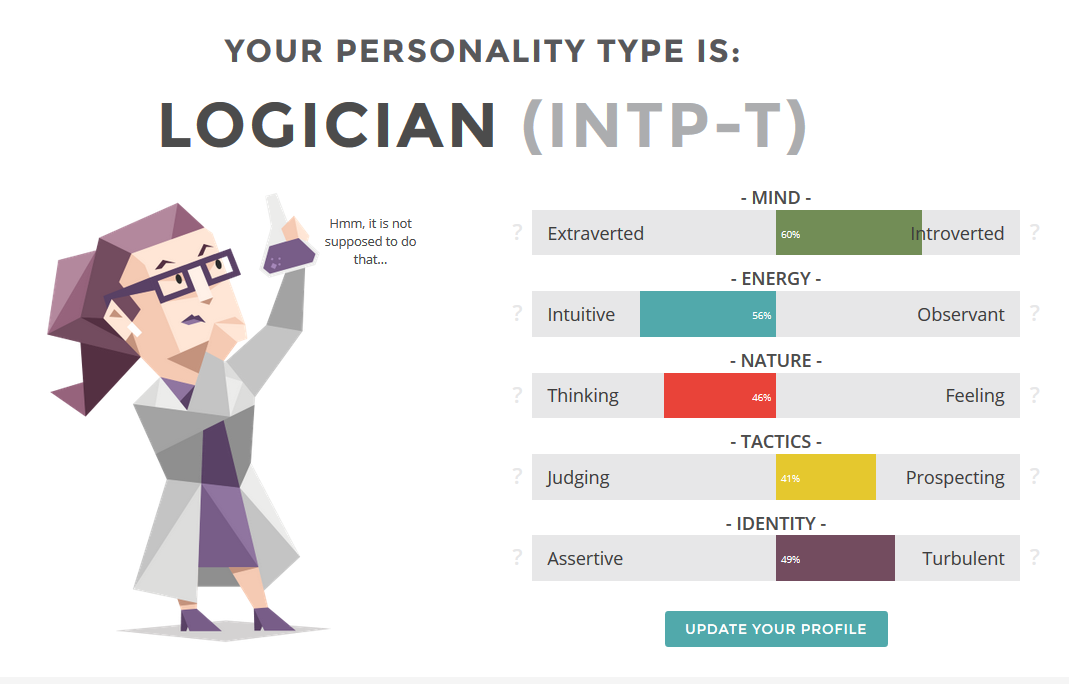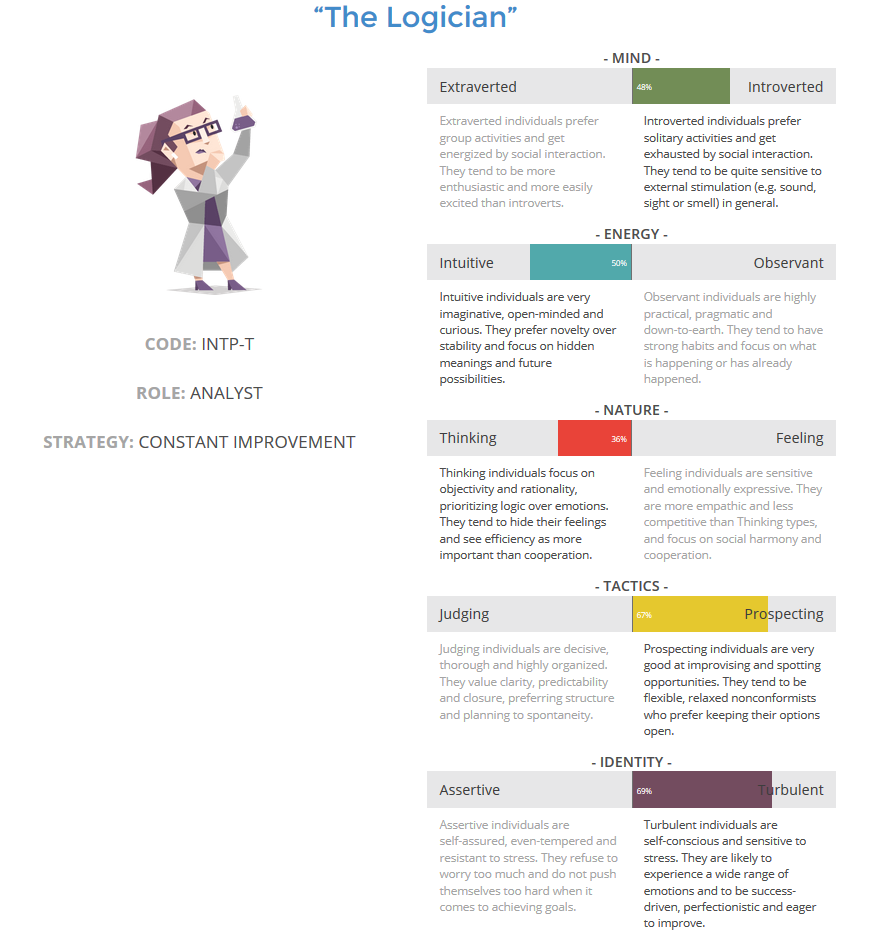Identifying the specifics of one’s personality and determining how these unique characteristics will shape one’s professional growth is a challenging task. Because of the large number of aspects, which a personality can be evaluated from, it is rather hard to keep the focus on what is important.
Herein the significance and doubtless superiority of the MBTI test compared to other personality analysis tools lies: it helps one assess one’s personality from a number of perspectives, at the same time keeping the focus on identifying the environment, in which the customer is likely to grow professionally and experience job satisfaction (Henkel, Marion, and Bordeaux 16).
Taking MBTI, one is likely to notice that it provides a detailed analysis of the aspects of one’s personality such as introversion/extroversion, intuitiveness/observation, thinking/feeling, judging/prospecting, and assertiveness/turbulence (“Our Theory” par. 1). Consequently, the possibility to determine whether one is likely to be a leader or a staff member, whether one likes to be a team member or to work on their own, etc. is provided.
The test, therefore, can be viewed as a rather valid tool for testing one’s personality. The number of aspects, which MBTI allows integrating into the assessment, creates premises for a very objective and detailed evaluation of the participant, therefore providing solid grounds for defining the tools that can be used for improving one’s process of knowledge and skills acquisition: “The personality profiles yielded by the MBTI are observed to enhance peer educator awareness of themselves and others during the training, and this is perceived as an essential starting point in developing their skills in helping others” (Munro 1).
Likewise, the tool in question can be used quite successfully in career counseling. Providing a sound foundation for making assumptions regarding one’s communication specifics, the degree of introversion and extroversion, and helping one locate one’s source of excitement and calm, MBTI serves as a perfect means of defining the leadership qualities and the ability of the candidate to communicate. Consequently, the process of determining the possible path of one’s career development becomes much easier: “certain personality types were more likely to be promoted than others” (Furnham and Crump 1515).
Claiming that MBTI defines the course of one’s career development entirely, however, would be quite a stretch. Whereas the aforementioned test can and should be incorporated into the array of techniques used for career counseling, it informs the strategy that a career council considers appropriate, yet does not necessarily define it.
The MBTI test provides a deep insight into the environment, in which the candidate is likely to feel encouraged for the further development, including personal and professional one; however, it does not restrict one to a particular amount of choices (Muller and Pennington 67).
Since the test under analysis offers a plethora of opportunities for an adequate evaluation of the client’s personality features and character traits, which determine the environment, in which one is likely to evolve professionally, the test should be included in the set of tools used by a career council. It should be borne in mind, though, that the tool under analysis only serves as the means of identifying the methods of discovering and developing the abilities of the client.
When used the proper way, MBTI will empower career councils to help their customers explore the latter’s strengths and weaknesses to identify the environment, in which they are likely to grow both personally and professionally.
Appendix A: MBTI Results

Appendix B: Results Description

Works Cited
Furnham, Adrian and John Crump. “The Myers-Briggs Type Indicator (MBTI) and Promotion at Work.” Psychology 2015.6 (2015): 1510–1515. Print.
Henkel, Thomas, James Marion, and Debra Bordeaux. “Researching MBTI Personality Types: Project Management Master’s Degree Students.” The Journal of Human Resource and Adult Learning 11.1 (2015): 14–23. Print.
Muller, Rick and Karen Pennington. “Using the Myers-Briggs Type Indicator® and Ignatian Pedagogy Model for Improved Learning in Master’s Level Finance Classes for Nurses.” Jesuit Higher Education 3.1 (2014): 64–74. Print.
Munro, Nicholas. “The Use of the Myers-Briggs Type Indicator in Peer Education: A Positive Psychological Approach to Peer Educator Training and Peer to Peer Based Interventions in Higher Education.” Journal of Counselling and Development in Higher Education Southern Africa 1.1 (2011): 1–11. Print.
Our Theory n. d. Web.
Your Personality Type Is: Logician (INTP-T). 2015. Web.